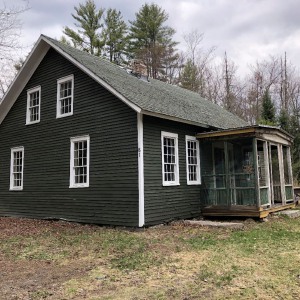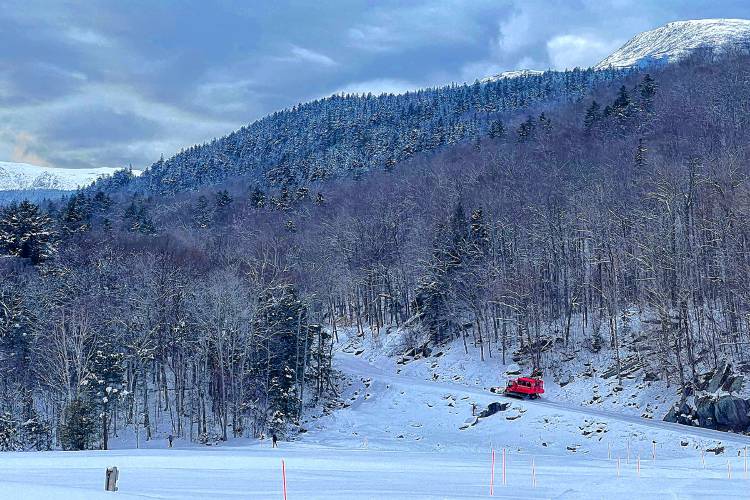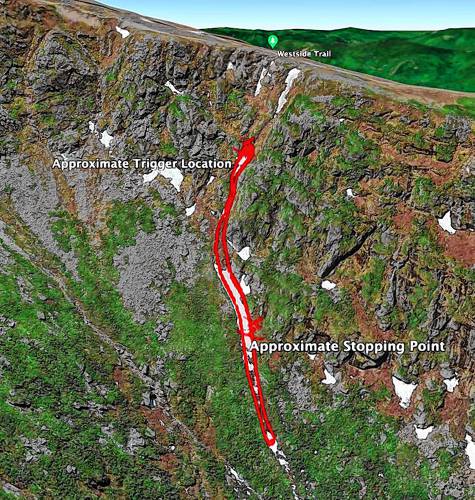NH skier recounts run that triggered avalanche in White Mountains
| Published: 12-24-2023 1:22 AM |
All systems were go for Dominic Torro earlier this month, just like always.
He had the gear and experience to conquer Airplane Gully — a steep chute on Mount Washington that he’d skied down dozens of times over the past few years.
He was trained on how to evaluate the snowpack for avalanche danger and watched a solo skier head down the same route with no problems just before he dropped in.
But during his descent of this unforgiving slope with rocks sticking out on either side of him, the snow gave way. As was the case on Dec. 9, not even the best training in the world can save you from the rushing snow of an avalanche.
Torro, despite testing the snow to make sure Airplane Gully was stable, rode an avalanche for what he said was about a minute. He suffered a compound fracture in his left leg and waited four hours for a helicopter to lift him to safety.
“I thought I could end up severely injured,” Torro said from Dartmouth Hitchcock Medical Center, where he had four surgeries. “The takeaway here is that you can never totally eliminate the hazards.”
Torro, who lives in Bow, N.H., was discharged from the hospital Wednesday morning. He said he felt fine and was looking forward to sleeping. He also said that once healed, he’ll continue to backcountry ski.
“Some people say the stuff I do is crazy,” Torro said.
Article continues after...
Yesterday's Most Read Articles
 Dartmouth administration faces fierce criticism over protest arrests
Dartmouth administration faces fierce criticism over protest arrests
 Hanover house added to New Hampshire Register of Historic Places
Hanover house added to New Hampshire Register of Historic Places
 Sharon voters turn back proposal to renovate school
Sharon voters turn back proposal to renovate school
Backcountry skiing involves getting yourself up and down the mountain, sometimes in remote areas.
“It’s human-powered skiing. No chairlifts,” Torro said. “It’s your own strength and willpower to get up the mountain and then ski down.”
Torro grew up in Bradford, N.H., and started skiing on Mount Sunapee at age 2 or 3. He played three sports at Kearsarge Regional High School and skied competitively for the United States Ski and Snowboard Association.
He took a break from skiing while studying at Keene State College and then returned with adventure in his heart. He’s skied in California, Colorado, Utah and Washington state. He’s skied most of the mountains in the Presidential Range.
Torro called Tuckerman’s Ravine, on the southeast face of Mount Washington, the birthplace of backcountry skiing in the Northeast. He no longer skies there. He wanted different challenges and found them in other areas of the state’s tallest mountain, including in Huntington’s Ravine, at Airplane Gully.
“I preferred a more remote zone in Mount Washington,” Torro said, “because I have the stamina and energy to do it.”
He backcountry skis about 50 times per year. He’s done Airplane Gully at least 35 times, without a hitch. Another seven or eight steep slopes are in the area. “I’ve skied most of them,” Torro said.
His vast resume and experience as a guide on Mount Washington, a mountaineer, an ice climber and a rock climber has caught the attention of several sponsors, who have paid for his gear. Further, he’s just two courses short of being labeled an avalanche educator.
To prepare, Torro and his friend performed a compression test to determine how much weight the snow in the Airplane Gully area could support. They jumped around in their skis near the start zone. And they were comforted by a line down the run that had already been established by another skier.
“Snow is in different layers,” Torro said, “and we do tests to see if we’ll trigger a weak layer. The snowpack at the top of (Airplane Gully) seemed stable.”
The slope is as steep as 38 degrees, and it didn’t take long once Torro began his planned 1,000-foot descent for a serious problem to surface. Torro said he skied one-third of the way down before his friend up top radioed him.
“Avalanche! Avalanche!” his friend said, according to Torro.
In a video, Torro can be seen zigzagging while skiing in control. A flat area of snow, estimated by Torro to be 15 feet wide, broke off and easily caught him from behind, knocking him sideways and sweeping him away through a narrow passageway, between two rock formations. He rode the wave for about a minute.
“I’m being carried down this mountain,” Torro said. “I managed to stay on top of the slide. You don’t want to get dragged below the snowpack. I tossed and turned and looked at my leg.”
His left ski did not release in what Torro called a binding malfunction. The bone had pushed through the skin. Torro said his leg was “flopping” below the knee.
He said he kept cool. He said he was awake the whole time and was not in shock. He and his friend were prepared with food, water, blankets, medical supplies, even a powder that helped his blood coagulate.
“I was completely calm,” Torro said. “Calm and collected.”
He was lifted into a helicopter after four hours and flown to Dartmouth Hitchcock Medical Center. He needed four surgeries and expects rehab to be a long, painful process.
He says he’ll return to backcountry skiing once healed. He’s got the experience and gear to navigate these treacherous trails. Some factors, though, are out of his control.
“I’m well aware of the danger,” Torro said. “It’s a dangerous sport. I do everything I can to be ready. Sometimes you just never know what could happen.”




 Students take down pro-Palestinian encampment at UVM
Students take down pro-Palestinian encampment at UVM
